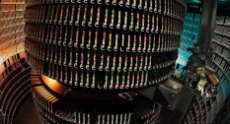NERSC’s Storage Strategy Paying Off in Savings
April 1, 2005
Since relocating to Berkeley Lab almost 10 years ago, one of NERSC’s goals has been to consistently introduce new technologies without creating bottlenecks. In a program of planned upgrades to tapes with greater density, the Mass Storage Group has not only achieved this goal, but will save $3.7 million over the course of five years. Over that same time, from 2003 to 2007, the amount of data stored will grow from just over 1 terabyte to 11.3 terabytes.
As computational science becomes increasingly data intensive, the need for storage has ballooned. When the NERSC Center moved into the Oakland Scientific Facility in 2000, the archival data were stored on 8,000 tape cartridges. Four years later, the silos housed 35,000 cartridges. While this increase is dramatic, the real growth indicator is that the amount of data stored on each cartridge has also risen by a factor of 10.
It is this planned switch to higher density cartridges that is at the heart of the Mass Storage Group’s investment strategy. The strategy of saving money by adopting the latest technology as soon as it is available flies in the face of conventional wisdom, which holds that by waiting for the technology to become pervasive, the price will drop.
Yet NERSC’s investment strategy is already paying off, saving an estimated $135,000 in 2004. By 2007, the annual savings is estimated at $2.3 million. In all, the program is expected to save $2,694,754 over five years. Here’s how it works.
At the start of the plan, data was stored on a mix of cartridges, each capable of holding either 20 or 60 gigabytes. To keep up with data growth, the group could either stick with the current cartridges -- and buy a lot of them – or adopt the newly available 200 gigabyte cartridges. While this switch would also require the center to buy new tape drives to read the denser tapes, the long-term costs showed that higher density meant lower overall costs.
For example, in 2004, data grew by 832,000 terabytes. Buying enough new lower-density (60 Gb) cartridges would have cost $497,952. Switching to the higher-density tapes cost $262,000. Buying new tape drives to read the denser cartridges cost another $100,000, but the strategy resulted in savings of $135,872. In 2005, when the group expects to upgrade to 500 gigabyte cartridges, the estimated savings will be $308,000 – even after accounting for new tape drives.
“It’s important to note that these savings only reflect the cost of the tapes,” said Nancy Meyer, leader of the Mass Storage Group. “It doesn’t include the money saved by not adding more silos or moving other systems to create more adjacent floor space.”
Other centers, according to Meyer, take the more traditional approach. Not only is this actually more expensive in the long run, but it also results in wholesale rather than incremental upgrades and these can be more disruptive to users.
NERSC users, Meyer said, don’t see much difference. Smaller files, amounting to about 10 percent of the total data, are still stored on 20-gigabtye cartridges. Finding a file on one of these tapes takes about 10 seconds. Locating a file on the denser tape takes about a minute, possibly 90 seconds. “While it takes a little longer to locate files, we think it’s a air tradeoff for almost $4 million in savings,” Meyer said.
About NERSC and Berkeley Lab
The National Energy Research Scientific Computing Center (NERSC) is a U.S. Department of Energy Office of Science User Facility that serves as the primary high performance computing center for scientific research sponsored by the Office of Science. Located at Lawrence Berkeley National Laboratory, NERSC serves almost 10,000 scientists at national laboratories and universities researching a wide range of problems in climate, fusion energy, materials science, physics, chemistry, computational biology, and other disciplines. Berkeley Lab is a DOE national laboratory located in Berkeley, California. It conducts unclassified scientific research and is managed by the University of California for the U.S. Department of Energy. »Learn more about computing sciences at Berkeley Lab.








